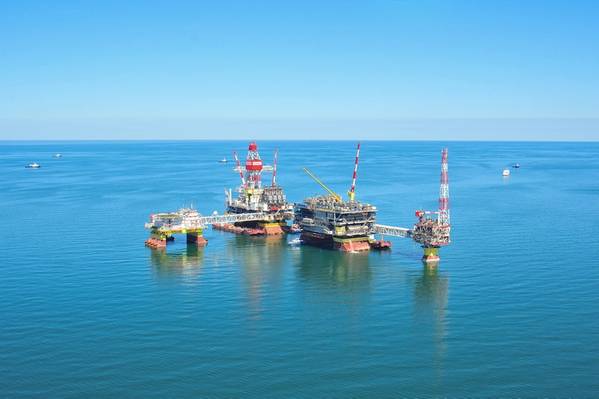
Alexander Oboronkov leapt at the chance to work on the Filanovsky platform after it was launched in 2016, keen to see Russia's largest Caspian Sea oilfield in action.
The Filanovsky oilfield, along with the nearby Korchagin and Rakushechnoye fields, are key to the growth plans at Lukoil, Russia's second biggest oil producer, where Oboronkov works as deputy head of the Filanovsky platform.
The company, controlled by executives Vagit Alekperov and Leonid Fedun, took its name from three oil towns in Lukoil's tradition exploration region of western Siberian: Langepas, Urai and Kogalym.
One of the ships that docks at the Filanovsky is named Langepas.
"The Langepas cargo ship which moves back and forward to the platform reminds me of my homeland - Siberia," said Oboronkov as he provided a tour of the platform. "One well here (by flow rate) is like 100 onshore," he noted.
The sea is about 10 meters deep around the Filanovsky platform, but to reach oil Lukoil needs to drill wells more than 2 km deep. The platform itself is fixed to the seabed by 60-meter-long concrete piles.
Production is expensive to begin with but promising once it is ramped up, Nikolay Lyashko, head of Lukoil Nizhnevolzhskneft, which is in charge of the Caspian projects, told Reuters.
Well site construction in the Caspian is 10 times more expensive than onshore, he said, but added that production costs are just a third of those in Russia's traditional oil region, western Siberia.
Production at the Filanovsky oilfield costs 650 roubles ($9.51) per tonne and the average well flow rate is 3,000 tonnes per day. That compares to over 2,000 roubles a tonne in western Siberia, where the average oil flow rate is around 40 tonnes a day.
"Last year we made a profit and now are starting to return the investment thanks to the wells' high flow performance," Lyashko told Reuters.
In total, Lukoil plans to build 25 offshore platforms in the Caspian Sea by 2030.
Lukoil also produces in shallow waters in the Baltic Sea near the Russian enclave of Kaliningrad but output is tiny compared to its current operations in the Caspian and its future plans.
By 2020, output from those shallow waters is expected to rise by more than a quarter from last year's levels to around 9 million tonnes, or 180,000 barrels per day - almost a tenth of Lukoil's current oil and gas production.
Lukoil's core oil production area remains western Siberia but it has its sights set on deepwater drilling.
But Russian authorities which granted an offshore exploration monopoly to state-controlled giants Gazprom and Rosneft in 2008 have not yet granted deepwater drilling rights to Lukoil.
In the meantime, Lukoil is involved in a deep water project in the Norwegian part of the Barents Sea among other international projects.
Alekperov said in October that Lukoil had the technology required to drill offshore wells in waters as deep as 2,800 meters.
($1 = 68.3825 roubles)
(Reporting by Olesya Astakhova; editing by Katya Golubkova and Jason Neely)